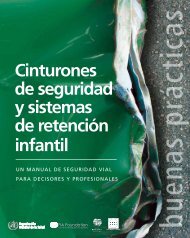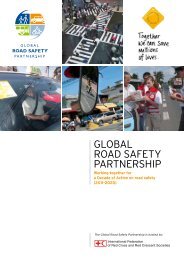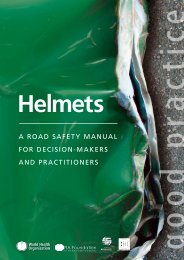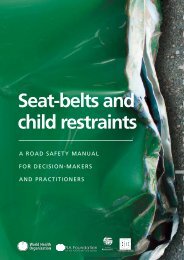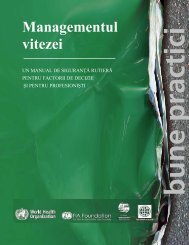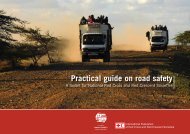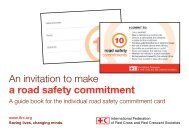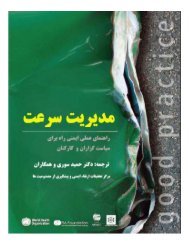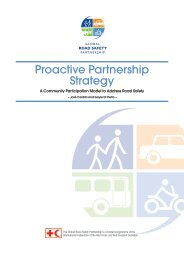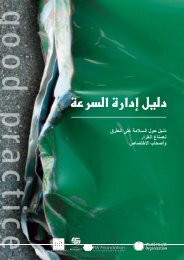How to design and implement a drinking and driving programme pdf ...
How to design and implement a drinking and driving programme pdf ...
How to design and implement a drinking and driving programme pdf ...
You also want an ePaper? Increase the reach of your titles
YUMPU automatically turns print PDFs into web optimized ePapers that Google loves.
Module 3: <strong>How</strong> <strong>to</strong> <strong>design</strong> <strong>and</strong> <strong>implement</strong> a <strong>drinking</strong> <strong>and</strong> <strong>driving</strong> <strong>programme</strong><br />
possibility of being detected if they have been <strong>drinking</strong>, <strong>and</strong> reduces their certainty<br />
that detection will not occur. Prevention strategies such as alcohol screening should:<br />
• be high profile <strong>and</strong> highly visible, using “sobriety checkpoints” or roadblock operations<br />
<strong>to</strong> ensure all drivers (or a high percentage of drivers) are tested;<br />
• include stationary vehicle checks at locations such as <strong>to</strong>ll gates, service stations <strong>and</strong><br />
rest s<strong>to</strong>ps.<br />
Some countries such as Australia allow for r<strong>and</strong>om alcohol screening, also known as<br />
r<strong>and</strong>om breath testing (RBT), of any driver at any time. Other countries, such as the<br />
United States, require traffic police <strong>to</strong> establish “probable cause” before a driver can<br />
be effectively screened for alcohol consumption in selective breath testing (SBT).<br />
R<strong>and</strong>om versus selective breath testing<br />
The US based Task Force on Community Preventive Services (2001) revealed that<br />
sobriety checkpoints of both types are effective in reducing crashes involving <strong>drinking</strong><br />
<strong>and</strong> <strong>driving</strong>, <strong>and</strong> have sizeable economic benefits. Crashes thought <strong>to</strong> involve<br />
<strong>drinking</strong> <strong>and</strong> <strong>driving</strong> dropped an average of 18% (for RBT checkpoints) <strong>and</strong> 20%<br />
(for SBT checkpoints) following <strong>implement</strong>ation of sobriety checkpoints, while fatal<br />
crashes thought <strong>to</strong> involve alcohol dropped a median of 22% (for RBT checkpoints)<br />
<strong>and</strong> 23% (for SBT checkpoints) following <strong>implement</strong>ation of sobriety checkpoints.<br />
Accurate measuring of alcohol in the bloodstream is a vital component of effective<br />
enforcement. It is critical <strong>to</strong> have a screening device which is practical <strong>and</strong> easy <strong>to</strong> use.<br />
Equipment that lapses in<strong>to</strong> disarray after a few months or needs expensive servicing<br />
outside the country of operation (with consequential additional costs <strong>and</strong> lack of<br />
continuity of use of the product) should be avoided (see Appendix 2).<br />
A minimum annual target of alcohol screening tests should be set <strong>and</strong> maintained.<br />
Testing can take place at <strong>design</strong>ated testing stations (checkpoints or roadblocks) or<br />
during normal police interceptions. The minimum targets set should relate <strong>to</strong> the<br />
percentage of the <strong>driving</strong> population tested during the year. A solid strategy aims <strong>to</strong><br />
test 1:3 drivers annually, although the more progressive enforcement bodies in richer<br />
countries aim at 1:1 – on average every driver would expect <strong>to</strong> be tested once per year.<br />
Targeted enforcement based on intelligence<br />
The second enforcement method commonly used is the detection of drink-drivers at<br />
specific locations, times, <strong>and</strong> under specific circumstances, including:<br />
• s<strong>to</strong>pping drivers as they leave selected alcohol distribution premises such as hotels,<br />
entertainment venues, night clubs, sporting venues <strong>and</strong> gaming venues that should<br />
be the subject of police attention on account of the high possibility that <strong>drinking</strong><br />
<strong>and</strong> <strong>driving</strong> may take place;<br />
84



